
Ronald Joseph Ryan was the last person to be legally executed in Australia. Ryan was found guilty of shooting and killing warder George Hodson during an escape from Pentridge Prison, Victoria, in 1965. Ryan's hanging was met with public protests by those opposed to capital punishment. Capital punishment was abolished in all states by 1985.

HM Prison Pentridge was an Australian prison that was established in 1851 in Coburg, Victoria. The first prisoners arrived in 1851. The prison closed on 1 May 1997.
The Old Castlemaine Gaol is a former prison, located in Castlemaine, Victoria, Australia. The building was modelled on Pentonville prison in London, replacing the original, designed by Inspector General John Price, which was never occupied. Built in 1861 to house offenders from the goldfields and nearby towns, it served various functions in the penal system before it was closed in 1990 and its prisoners transferred to HM Prison Loddon.

HM Prison Beechworth, now known as Beechworth Gaol, was a medium security Australian prison located in Beechworth, Victoria, Australia.

The Old Melbourne Gaol is a former jail and current museum on Russell Street, in Melbourne, Victoria, Australia. It consists of a bluestone building and courtyard, and is located next to the old City Police Watch House and City Courts buildings, and opposite the Russell Street Police Headquarters. It was first constructed starting in 1839, and during its operation as a prison between 1845 and 1924, it held and executed some of Australia's most notorious criminals, including bushranger Ned Kelly and serial killer Frederick Bailey Deeming. In total, 133 people were executed by hanging. Though it was used briefly during World War II, it formally ceased operating as a prison in 1924; with parts of the jail being incorporated into the RMIT University, and the rest becoming a museum.
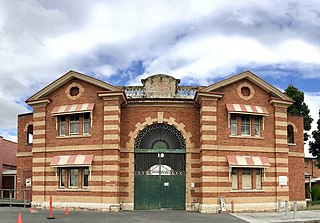
H.M. Prison Brisbane, more commonly known as Boggo Road Gaol, was Queensland's main prison from the 1880s to the 1980s. By the time it closed, it had become notorious for poor conditions and rioting. Located on Annerley Road in Dutton Park, an inner southern suburb of Brisbane, it is the only surviving intact gaol in Queensland that reflects penological principles of the 19th century. After closing in 1992, the larger 1960s section was demolished, leaving the heritage listed section.
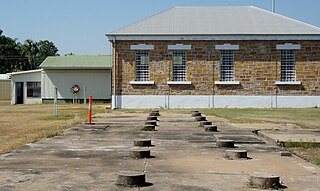
Fannie Bay Gaol is a historic gaol in Fannie Bay, Northern Territory, Australia. The Gaol operated as Her Majesty's Gaol and Labour Prison, from 20 September 1883 until 1 September 1979. Glen SUTTON was the last Superintendent of Fannie Bay and the first Superintendent of the new Goal at Berrimah.
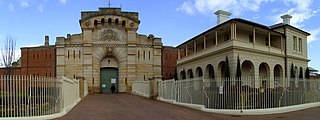
Bathurst Correctional Centre, originally built as Bathurst Gaol in 1888, is a prison for men and women located in the city of Bathurst, New South Wales, Australia, and operated by the Department of Communities and Justice. Bathurst holds inmates sentenced under State or Australian criminal law, along with a small number of remand prisoners.
Aradale Mental Hospital was an Australian psychiatric hospital, located in Ararat, a rural city in south-west Victoria, Australia. Originally known as Ararat Lunatic Asylum, Aradale and its two sister asylums at Kew and Beechworth were commissioned to accommodate the growing number of 'lunatics' in the colony of Victoria. Construction began in 1864, and the guardhouses are listed as being built in 1866 though the list of patients extends as far back as the year before (1865). It was closed as an asylum in 1998 and in 2001 became a campus of the Melbourne Polytechnic administered Melbourne Polytechnic's Ararat Training Centre.

Collingwood Stockade was a penal stockade in modern-day Carlton North, Victoria, Australia. It was built in 1853 and was in use until 1866 when it was converted into an asylum, which then closed in 1873. The stockade no longer exists but the area has several reminders of it, including the Stockade Hotel on Nicholson Street and Lee St Primary School which is built on the site of the old stockade buildings.
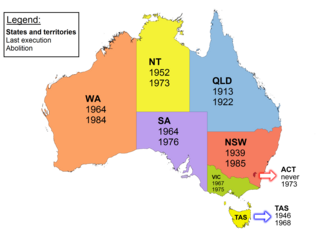
Capital punishment in Australia has been abolished in all jurisdictions since 1985. Queensland abolished the death penalty in 1922. Tasmania did the same in 1968. The Commonwealth abolished the death penalty in 1973, with application also in the Australian Capital Territory and the Northern Territory. Victoria did so in 1975, South Australia in 1976, and Western Australia in 1984. New South Wales abolished the death penalty for murder in 1955, and for all crimes in 1985. In 2010, the Commonwealth Parliament passed legislation prohibiting the re-establishment of capital punishment by any state or territory. Australian law prohibits the extradition or deportation of a prisoner to another jurisdiction if they could be sentenced to death for any crime.

The Ballarat Gaol, a former maximum security prison for males, females and children, is located in Ballarat, Victoria, Australia. Replacing temporary structures including prison hulks in the Bay of Port Phillip and holding yards in Ballarat, the gaol operated between 1862 and 1965.

Kew Lunatic Asylum is a decommissioned psychiatric hospital located between Princess Street and Yarra Boulevard in Kew, a suburb of Melbourne, Australia. Operational from 1871 to 1988, Kew was one of the largest asylums ever built in Australia. Later known as Willsmere, the complex of buildings were constructed between 1864 and 1872 to the design of architects G.W. Vivian and Frederick Kawerau of the Victorian Public Works Office to house the growing number of "lunatics", "inebriates", and "idiots" in the Colony of Victoria.

Yarra Bend Asylum was the first permanent institution established in Victoria that was devoted to the treatment of the mentally ill. It opened in 1848 as a ward of the Asylum at Tarban Creek in New South Wales. It was not officially called Yarra Bend Asylum until July 1851 when the Port Phillip District separated from the Colony of New South Wales. Prior to the establishment of Yarra Bend, lunatic patients had been kept in the District's gaols. Yarra Bend was proclaimed an Asylum under the provisions of the Lunacy Statute 1867 (No.309) in the Government Gazette in October 1867.
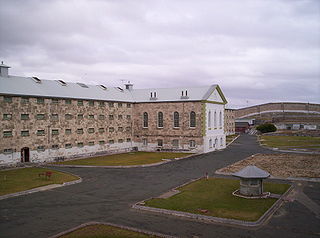
Punishment in Australia arises when an individual has been accused or convicted of breaking the law through the Australian criminal justice system. Australia uses prisons, as well as community corrections. When awaiting trial, prisoners may be kept in specialised remand centres or within other prisons.

The County Gaol, situated in North Parade, Monmouth, Wales, was Monmouthshire's main prison when it was opened in 1790. It served as the county jail of Monmouthshire and criminals or those who fell foul of the authorities were hanged here until the 1850s and some 3,000 people viewed the last hanging. The jail covered an area of about an acre, with a chapel, infirmary, living quarters and a treadmill. It was closed in 1869. In 1884 most of the building was demolished, and today nothing remains but the gatehouse which is a Grade II listed building. Within the gatehouse, there exists "a representation in coloured glass of the complete original buildings". It is one of 24 buildings on the Monmouth Heritage Trail.

Thomas William Johnson murdered two residents of a boarding house in the delicensed Windsor Castle Hotel in Dunolly, Victoria, in October 1938. He was an itinerant labourer with a record of violence and petty crime. Johnson confessed to the brutal killings, but at his trial he pleaded not guilty for reason of insanity. He was convicted and executed at Pentridge Prison in January 1939. Johnson was the fourth of eleven people to be hanged at Pentridge Prison after the closure of Melbourne Gaol in 1924.

Alexander Green was an Australian executioner. He arrived in the colony of New South Wales in 1824 as a convict and was granted a Certificate of Freedom in 1831. During the period 1826 to late 1833 Green was employed as a flagellator, or scourger, at Sydney, Port Stephens and the Hunter Valley, inflicting floggings on those who had received a sentence of corporal punishment. In February 1834 he was appointed as the colony's public executioner, beginning a career of twenty-one years during which Green carried out about 250 hangings. During most of his employment as the New South Wales hangman, judicial executions were able to be viewed by the public. His last execution in February 1855 was the first private hanging after the enactment of legislation to abolish public executions in New South Wales. Towards the end of his career Green's behaviour became increasingly erratic due to drunkenness and mental instability. He was declared to be insane in April 1855 and committed to a lunatic asylum. Alexander Green died at the Parramatta Asylum on 31 August 1879.[A]

Charles Lucas Edmond Kindel Sidi Foussard was a French Australian man who spent most of his life confined in the J Ward mental asylum in Ararat, Victoria after murdering an elderly man and stealing his boots. He died while still incarcerated at 91–92 years of age, making this the longest served prison sentence in the world with a definite end.


















